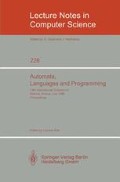Abstract
Much complexity-theoretic work on parallelism has focused on the class NC, which is defined in terms of logspace-uniform circuits. Yet P-uniform circuit complexity is in some ways a more natural setting for studying feasible parallelism. In this paper, P-uniform NC (PUNC) is characterized in terms of space-bounded AuxPDA's and alternating Turing Machines with bounded access to the input. We also present a general-purpose parallel computer for PUNC; this characterization leads to an easy proof that NC = PUNC iff all tally languages in P are in NC. The characterizations of PUNC lead to natural methods for modelling precomputation. We show that for many classes of interest, there is a single “universal” table which can be used in place of any table of similar size and complexity, while for certain other classes, no such “universal” table exists.
Extended Abstract
Portions of this research were carried out while the author was supported by NSF grant MCS 81-03608.
Preview
Unable to display preview. Download preview PDF.
References
L. Adleman, Two theorems on random polynomial time, Proc. 19th IEEE Symposium on Foundations of Computer Science, pp. 307–311.
E. W. Allender, Invertible functions, Doctoral Dissertation, Georgia Institute of Technology.
E. W. Allender, The complexity of sparse sets in P, Paper presented at the Structure in Complexity Theory Conference, Berkeley, to appear in Lecture Notes in Computer Science.
J. L. Balcazar, J. Diaz, J. Gabarro, On some “non-uniform” complexity measures, 5th Conference on Mathematical Foundations of Computer Science, Lecture Notes in Computer Science 199, pp. 18–27.
P. W. Beame, S. A. Cook, and H. J. Hoover, Log depth circuits for division and related problems, Proc. 25th IEEE Symposium on Foundations of Computer Science, pp. 1–11.
R. V. Book, Tally languages and complexity classes, Information and Control 26, 186–193.
F.-J. Brandenburg, On one-way auxiliary pushdown automata, Proc. 3rd GI Conference, Lecture Notes in Computer Science 48, pp. 133–144.
F.-J. Brandenburg, The contextsensitivity of contextsensitive grammars and languages, Proc. 4th International Colloquium on Automata, Languages and Programming, Lecture Notes in Computer Science 52, pp. 272–281.
A. K. Chandra, L. J. Stockmeyer, U. Vishkin, Constant depth reducibility, SIAM J. Comput. 13, 423–439.
M. P. Chytil, Comparison of the active visiting and the crossing complexities, Proc. 6th Conference on Mathematical Foundations of Computer Science, Lecture Notes in Computer Science 53, pp. 272–281.
S. A. Cook, Towards a complexity theory of synchronous parallel computation, L'Enseignement Mathematique 27, 99–124.
S. A. Cook, The classification of problems which have fast parallel algorithms. Proc. 4th International Conference on Foundations of Computation Theory, Lecture Notes in Computer Science 158, pp. 78–93.
P. W. Dymond and S. A. Cook, Hardware complexity and parallel computation, Proc. 20th IEEE Symposium on Foundations of Computer Science, pp. 360–372.
J. von zur Gathen, Parallel powering, Proc. 25th Annual ACM Symposium on Theory of Computing, pp. 31–36.
Z. Galil, Some open problems in the theory of computation as questions about two-way deterministic pushdown automaton languages, Mathematical Systems Theory 10, 211–228.
Z. Galil and W. Paul, An efficient general-purpose parallel computer, J. ACM 30, 360–387.
A. V. Goldberg and M. Sipser, Compression and ranking, Proc. 17th Annual ACM Symposium on Theory of Computing, pp. 440–448.
L. M. Goldschlager, A universal interconnection pattern for parallel computers, J. ACM 29, 1073–1086.
J. Hartmanis, Generalized Kolmogorov complexity and the structure of feasible computations, Proc. 24th IEEE Symposium on Foundations of Computer Science, pp. 439–445.
J. Hartmanis and Y. Yesha, Computation times of NP sets of different densities, Theoretical Computer Science 34, 17–32.
D. T. Huynh, Non-uniform complexity and the randomness of certain complete languages, Technical Report TR 85–34, Computer Science Department, Iowa State University.
N. D. Jones, Space-bounded reducibility among combinatorial problems, J. Computer and System Sciences 11, 68–85.
R. M. Karp and R. J. Lipton, Turing machines that take advice, L'Enseignement Mathematique 28, 191–209.
K. N. King, Measures of parallelism in alternating computation trees, Proc. 13th Annual ACM Symposium on Theory of Computing, pp. 189–201.
K.-I. Ko, On the definition of some complexity classes of real numbers, Mathematical Systems Theory 16, 95–109.
K.-I. Ko, A definition of infinite pseudorandom sequences, manuscript, University of Houston.
N. Pippenger, Pebbling with an auxiliary pushdown, J. Computer and System Sciences 23, 151–165.
C. Rackoff, personal communication.
W. L. Ruzzo, On uniform circuit complexity, J. Computer and System Sciences 21, 365–383.
W. L. Ruzzo, personal communication.
L. J. Stockmeyer, The complexity of decision problems in automata theory and logic, Doctoral Dissertation, M.I.T.
I. H. Sudborough, Bandwidth constraints on problems complete for polynomial time, Theoretical Computer Science 26, 25–52.
U. Vishkin, Synchronous parallel computation — a survey, preprint, Courant Institute, New York University.
U. Vishkin, A parallel-design distributed-implementation (PDDI general-purpose computer), Theoretical Computer Science 32, 157–172.
G. Wechsung, The oscillation complexity and a hierarchy of context-free languages, Proc. 2nd Proc. 2nd International Conference on Fundementals of Computation Theory, Akademie-Verlag, Berlin, GDR, pp. 508–515.
G. Wechsung, A note on the return complexity, Elektronische Informationsverarbeitung und Kybernetik 16, 139–146.
G. Wechsung and A. Brandstadt, A relation between space, return and dual return complexities, Theoretical Computer Science 9, 127–140.
Author information
Authors and Affiliations
Editor information
Rights and permissions
Copyright information
© 1986 Springer-Verlag Berlin Heidelberg
About this paper
Cite this paper
Allender, E.W. (1986). Characterizations of PUNC and precomputation. In: Kott, L. (eds) Automata, Languages and Programming. ICALP 1986. Lecture Notes in Computer Science, vol 226. Springer, Berlin, Heidelberg. https://doi.org/10.1007/3-540-16761-7_49
Download citation
DOI: https://doi.org/10.1007/3-540-16761-7_49
Published:
Publisher Name: Springer, Berlin, Heidelberg
Print ISBN: 978-3-540-16761-7
Online ISBN: 978-3-540-39859-2
eBook Packages: Springer Book Archive

